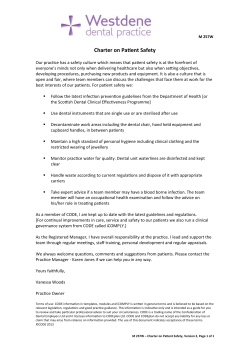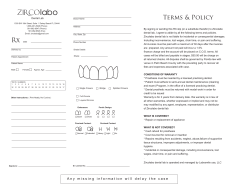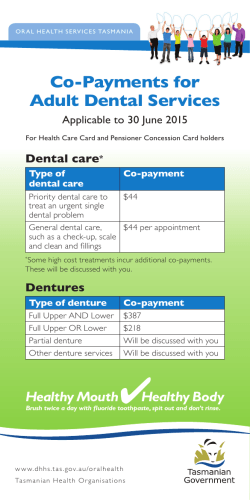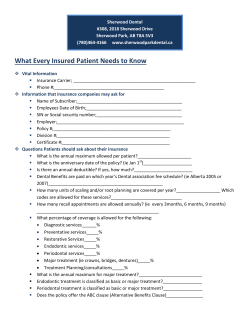
Hemophilia and oral health Ruta Zaliuniene, Vytaute Peciuliene
REVIEWS SCIENTIFIC ARTICLES Stomatologija, Baltic Dental and Maxillofacial Journal, 16: 127-131, 2014 Hemophilia and oral health Ruta Zaliuniene, Vytaute Peciuliene, Vilma Brukiene, Jolanta Aleksejuniene Summary Objective. The aim was to overview the oral health aspects in hemophilia patients. Material and methods. An electronic search of Medline (Pub Med), Cochrane, SSCI (Social Citation Index), SCI (Science Citation Index) databases from 1982 to the present, using the following search words: hemophilia, oral health, dental caries, dental caries prevalence, gingivitis, periodontitis, primary dentition, permanent dentition, dental treatment and review, was performed. The search yielded 196 titles and abstracts on chosen words. All articles were full-text reviewed and 40 of publications were included. Results. Nowadays coagulation factor abnormalities are the most common of inherited bleeding disorders, but occur much less frequently approximating 10 000 - 50 000 male births than acquired coagulation defects. Von Willebrand disease, Hemophilia A and Hemophilia B account for 95–97% of all coagulation deficiencies. Hemophilias A and B are subdivided according to the factor’s activity levels in the blood: mild, moderate or severe. The two main oral diseases affecting patients with hemophilia are the same as for the rest of population, i.e. dental caries and gingivitis/periodontitis. Only a few studies concerning oral health aspects in hemophilia patients were carried out. Some controversy exists concerning caries prevalence in both primary and permanent dentitions in children with hemophilia. People with congenital hemorrhagic diatheses constitute a very small proportion of the total population. Due to that fact treatment of such patients becomes a challenge to the most of dentists due to the fact that most of them have no experience in dealing with dental problems in such patients. Conclusion. There is a lack of epidemiological studies in oral health status of hemophilia patient. Key words: hemophilia, oral health, caries, periodontitis, dental treatment. Introduction Two categories of bleeding disorders exist: inherited (congenital) and acquired (1). According to the historical sources the prevalence of hemophilia in the early part of the last century was estimated to be 4 per 100 000 males (2). Nowadays coagulation factor abnormalities are the most common of inherited bleeding disorders, but occur much less frequently approximating 10 000 - 50 000 male births than acquired coagulation defects (3, 4). Growth of Institute of Odontology, Faculty of Medicine, Vilnius University, Lithuania 2 Faculty of Dentistry, University of British Columbia, Vancouver, Canada 1 Ruta Zaliuniene1 – D.D.S., assist. prof. Vytaute Peciuliene1 – D.D.S., PhD., prof. Vilma Brukiene1 – D.D.S., PhD., assoc. prof. Jolanta Aleksejuniene2 – D.D.S., PhD., assoc. prof. Address correspondence to Prof. Vytaute Peciuliene, Institute of Odontology, Faculty of Medicine, Vilnius university Zalgirio str. 115, LT-08217, Lithuania. E-mail address: vytaute.peciuliene@mf.vu.lt Stomatologija, Baltic Dental and Maxillofacial Journal, 2014, Vol. 16, No. 4 the incidence of this disease could be related to the progression of tools, more sensitive diagnostic techniques used and also to the fact that is evident that both respective clotting factor genes F8 and F9 are committed to new mutations (5). The most frequently occurring congenital plasmatic hemorrhagic diathesis is hemophilia. Hemophilia is an X-linked bleeding disorder caused by a deficiency of two coagulation factors: VIII (FVIII) or IX (FIX) (4). Von Willebrand disease, Hemophilia A and Hemophilia B account for 95–97% of all coagulation deficiencies (5, 6). Von Willebrand disease is described as a deficiency of von Willebrand factor, leading to a hematologic disorder and is the most frequently inherited bleeding disorder, affecting 0.8-2% of the general population in Europe and America (7-9). Von Willebrand’s factor circulates in a non-covalent complex with factor VIII and plays a crucial role in the adhesion of platelets to the sub-endothelium during vascular injury. However this disease often remains 127 R. Zaliuniene et al. undiagnosed and existing data on prevalence does not indicate the actual prevalence of it (8, 9). Sadler classified this disease into three types which all are inherited in an autosomal-dominant manner (10, 11). Types I and III are associated with partial and total deficiency of von Willebrand factor, respectively. Type II represents a qualitative disorder (11). Thus, this study aimed was to overview the oral health aspects in hemophilia patients. SEARCH METHODOLOGY An electronic search of Medline (Pub Med), Cochrane, SSCI (Social Citation Index), SCI (Science Citation Index) databases from 1982 to the present, using the following search words: hemophilia, oral health, dental caries, dental caries prevalence, gingivitis, periodontitis, primary dentition, permanent dentition, dental treatment and review, was performed. The search yielded 196 titles and abstracts on chosen words. All articles were full-text reviewed and 40 of publications were included. CONGENITAL BLEEDING DISORDERS Both types of hemophilia A and B have the same clinical appearance, but their incidence is different. Hemophilia A is related to the deficiency of factor VIII and occurs in 80-85% of patients and has an incidence of 1: 5 000 in the male population (12). Hemophilia B (or Christmas disease) is a deficiency of factor IX and is diagnosed 10 times less frequent than hemophilia A. It accounts 10-15% of hemophilia cases with the incidence of 1:15 000 (13, 14). The deficiency in factor IX may have three different pathogenic mechanisms: inefficient activation, insufficient binding and decreased half-life of factor IX (13). Hemophilias A and B are subdivided according to the factor’s activity levels in the blood: mild, moderate or severe (15) (Table 1). Now it is going on discussion that disease severity could be determined by the manifestations of the disease rather than the level of factor activity in the blood (16). Their (Hemophilias A and B severity) differentiation is REVIEWS related to the laboratory tests. Screening tests show a prolonged activated partial thromboplastin time in severe and moderate cases but may not show prolongation in mild hemophilia (5). During last decades the molecular genetic diagnosis enhanced understanding of the proteins involved of bleeding disorders. Two different approaches of the genetic evaluation of bleeding disorders now are used: to track the defective chromosome in the family (linkage analysis) or identification of the disease-causing mutation in the patient’s coagulation factor gene (direct mutation detection) (17, 18). It is well known that main consequences of bleeding episodes in hemophilic patients are: hemarthrosis 70-80%, muscle/soft tissue bleeding 10-20%. Bleeding affects joints with predominant sequence: knee (45%), elbow (30%) and ankle (15%). These bleedings result in joint pain, swelling, decreased range motion (19). Other major bleedings account 5-10%. Bleeding from central nervous system (CNS) constitutes less than 5% (20). Accurate and timely diagnosis is important and essential for effective management of patients. According to the guidelines hemophilia should be suspected in patients with easy bruising in early childhood, spontaneous bleeding and excessive bleeding following trauma or surgery (20). It is well known that children even with severe form of hemophilia may have no bleeding episodes until they begin exploring world on their own. Results of studies showed that as many as 1/3 of all cases of hemophilia are the result of spontaneous mutation of factor VIII and IX genes where there was no prior family history (5). PREVALENCE OF ORAL DISEASES IN HEMOPHILIACS The two main oral diseases affecting patients with hemophilia are the same as for the rest of population, i.e. dental caries and gingivitis/periodontitis. It is conceivable that congenital coagulation disorders are risk factors for dental caries, gingivitis, periodontitis and subsequent alveolar bone loss due to the fact that these patients are afraid to use an everyday Table 1. Findings of clinical evaluation of patients’ complaints in all stages of investigation Severity Severe Clotting factor level < 1 IU dL -1 (< 0.01 IU mL-1) or < 1% of normal Moderate 1-5 IU dL -1 (0.01-0.05 IU mL-1) or 1-5% of normal Mild 5-40 IU dL -1 (0.005-0.40 IU mL-1) or 5 to < 40% of normal 128 Bleeding episodes Spontaneous bleeding into joints or muscles, predominantly in the absence of identifiable hemostatic challenge Occasional spontaneous bleeding; prolonged bleeding with minor trauma or surgery Severe bleeding with major trauma or surgery, spontaneous bleeding is rare Stomatologija, Baltic Dental and Maxillofacial Journal, 2014, Vol. 16, No. 4 REVIEWS R. Zaliuniene et al. prophylactic measures in proper way in order to avoid bleeding episodes (21). Only a few studies concerning oral health aspects in hemophilia patients were carried out. Some controversy exists concerning caries prevalence in both primary and permanent dentitions in children with hemophilia. The study from Northern Ireland showed a significantly greater proportion of caries-free children among hemophiliacs: 66% (in age 2-10 years group) and 73% (in age 7-15 years group) while in healthy groups results were 45% and 41% respectively (14, 22, 23). DMFT index was significantly higher in the controls (2.3) compared with the hemophilic children (0.45) (14, 22). No teeth had been extracted due to the caries and a high level of fluoride usage was claimed among hemophiliacs (14). The explanation of such differences could be due to better understanding among hemophiliacs and their parents the importance of periodical attendance for dental treatment and individual and professional dental hygiene. In addition, it could be speculated that patients with hemophilia receive a more vigorous dental caries prevention program than the general population. For instance, in countries with highly developed systems for caries prevention, e.g. Scandinavian countries, patients with congenital blood coagulation defects are involved in special preventive programs (24-26). However, there are countries presenting opposite results regarding oral health status of hemophiliacs. A study from Poland showed that oral hygiene status was worse in the group of hemophiliacs compared to the controls (27). A higher prevalence of decayed, missing and filled teeth among population suffering from severe type of hemophilia A and B was reported elsewhere (28). Worse oral hygiene was observed even when the consumption of sugars was less frequent in the hemophilia group, the DMF(T) and DMF(S) values were found significantly higher (29). An Egyptian study found significantly higher DMF-T index in hemophiliac children (average age 7–8 years) compared with non-hemophilic controls (30). Similar results were reported in the group of 16 years old hemophiliacs in Pakistan (28). In a Lithuanian study, comparing overall caries experience between children with hemophilia and their matched healthy controls. Deciduous teeth in children with hemophilia had more than a twice lower overall Table 2. Local anesthetic techniques No hemostatic cover required Buccal infiltration Intra-papillary injections Intraligamentary injections Hemostatic cover required Inferior dental block Lingual infiltration Stomatologija, Baltic Dental and Maxillofacial Journal, 2014, Vol. 16, No. 4 caries experience as compared to healthy children. Overall caries experience in the permanent dentitions did not differ between the cases and controls (31). Inflammatory disorders of the marginal periodontium, gingivitis and periodontitis, are among the most prevalent diseases worldwide. About 80–90% of the people above age of 35 are affected (32). Hemophiliacs were reported to have significantly higher gingival indices and more alveolar bone loss than controls: moderate to severe periodontitis was more prevalent among hemophilia patients (80%) compared with healthy controls (48%) based on radiological assessment of alveolar bone loss (21). Similarly, gingival health of children with hemophilia was found to be significantly worse than in the control group (29). HEMOPHILIA AND ORAL HEALTH CARE People with congenital hemorrhagic diatheses constitute a very small proportion of the total population. Due to that fact treatment of such patients becomes a challenge to the most of dentists due to the fact that most of them have no experience in dealing with dental problems in such patients (33). Consequently, hemophiliacs often face difficulties in accessing primary dental care (34). Meanwhile, majority of the patients with hemophilia can be handled in private dental practice. Consideration has to be given to the fact that mild hemophilia may not be diagnosed until adolescence if surgery, severe trauma or dental extractions have been avoided. Thus, in some cases a dentist may be the first to diagnose a patient with hemophilia. Hemophiliacs are a specific group of patients due to the fact that routine dental treatment can be lifethreatening. It was shown that 14% of all hemophilia patients and 30% of cases with mild type have been initially diagnosed following an episode of severe oral bleeding (35). The most common site of oral bleeding was the labial frenulum and the tongue (36). Episodes of spontaneous bleeding can occur in the patients during tooth brushing, food abrasion or with periodontal disease due to the number of enlarged capillaries close to the surface of the thinner regions of the gingiva (37). Maintaining good oral health is a priority in patients with congenital bleeding disorders. Hemophiliacs may need multiple visits to achieve this task, however. Success in dental management of hemophilia patients is the result of cooperation between hematologists and dentists (38). In general, routine examinations and dental care do not require raising the factor level, but adequate coverage is required prior to, and possibly after, 129 R. Zaliuniene et al. more intensive treatments such as deep cleaning or removal of heavy plaque/tartar (20). In some cases, however, safe dental treatment can be carried out only in the hospital or community dental services (CDS). ‘Guidelines for dental treatment of patients with inherited bleeding disorders’ (The World Federation of Hemophilia 2006) suggest that surgery, extractions and any dental treatment requiring inferior alveolar block anaesthesia and lingual infiltration anaesthesia are the only treatments that require referral to hospital or CDS (39). Periodontal surgery in patients with bleeding disorders must always be regarded as a high-risk procedure with a significant risk of blood loss. It can be a greater challenge to hemostasis than a simple extraction (4). Local anaesthesia is an important procedure during dental treatment. Inferior alveolar blocks require factor replacement as there is a risk of bleeding into the surrounding muscles due to the rich vasculature and blind injection, which could potentially compromise the airway due to hematoma formation in the retromolar or pterygoid spaces. However, with the appearance of Sol. Articaine as local anaesthetic, in several studies it was shown that inferior alveolar block could be avoided and buccal infiltrations in the mandible can be used as an alternative to inferior alveolar blocks (40). The intraligamental technique or interosseous technique could be also considered as alternatives to the mandibular block (Table 2). Lingual infiltrations similarly can lead to hematoma REVIEWS formation (39). There are no restrictions regarding the choice of the type of the local anesthetic agent used, although those with vasoconstrictors may provide additional local hemostasis (4). All oral surgery treatment plans must be discussed with hematologists if they involve the use of prophylactic cover. The use of antibiotics to treat an acute bacterial infection should be considered for all patients with inherited bleeding disorders since surgical intervention should be avoided if possible (4). The use of any non-steroidal anti-inflammatory drug must be discussed beforehand with the patient's hematologist because of their effect on platelet aggregation. Careful pre-operative planning and the use of antifibrinolytic agents will prevent many postoperative problems (38). Therefore, the ideal solution in successful management of patients with hemophilia could be a multidisciplinary medical team including oral health care specialists. CONCLUSION Improvement in communication among hematologists, hospital dental specialists, and those in general dental practices could be an important step to establish an effective dental management of patients with hemophilia. There is a lack of epidemiological studies in oral health status of hemophilia patients. The available data is controversial and countrydependent. REFERENCES 1. Vassilopoulos Ph, Palcanis K. Bleeding disorders and periodontology. Periodontology 2000 2007;44:211–223. 2. Rosendaal FR, Smit C, Briet E. Hemophilia treatment in historical perspective: a review of medical and social developments. Ann Hematol 1991;62:5–15. 3. Peyvandi F, Duga S, Akhavan S, Mannucci PM. Rare coagulation deficiencies. Haemophilia 2002;8:308–321. 4. Srivastava A, Brewer AK, Mauser-Bunschoten EP, Key NS, Kitchen S, Llinas A, Ludlam CA, Mahlangu JN, Mulder K, Poon MC, Street A. Guidelines for the management of hemophilia. Haemophilia 2013;19:e1–e47. 5. Mannucci PM, Tuddenham EGD. The hemophilias: from royal genes to gene therapy. N Engl J Med 2001;344:1773– 9. 6. Manucci PM. Hemophilia: treatment options in the twentyfirst century. J Thromb Haemost 2003;1:1349–55. 7. Handin RI, Ewenstein BM. Von Willebrand’s disease. In Handin R.I. et al. editors. Blood Principles and Practice of Hematology, 2nd ed. Philadelphia: Lippincott Williams & Wilkins; 2003. p.1103–1130. 8. Werner E. Willebrand disease in children and adolescents. Pediatr Clin North Am 1996;43:684–707. 9. Werner EJ, Broxson EH, Tucker WL, Girous DS, Shults J, Abshire TC. Prevalence of von Willebrand disease in children: a multiethnic study. J Pediatr 1993;123:893–898. 10.Sadler JE. A revised classification of von Willebrand disease. Thromb Haemost 1994;71:520–525. 130 11.Ewenstein BM. Willebrand’s disease. Annu Rev Med 1997;48:525–542. 12.Blanchette VS, Sparling C, Turner C. Inherited bleeding disorders. Bailliere's Clin Haematol 1991;4:291-332. 13.Cohen AJ, Kessler CM. Treatment of inherited coagulation disorders. Am J Med 1995;99:675–682. 14.Boyd D, Kinirons M. Dental caries experience of children with haemophilia in Northern Ireland. International Journal of Paediatric Dentistry 1997;7:149- 153. 15.White G, Rosendaal F, Aledort LM, Lusher JM, Rothschild C, Ingerslev J. Definitions in hemophilia. Recommendation of the scientific subcommittee on factor VIII and factor IX of the scientific and standardization committee of the International Society on Thrombosis and Haemostasis. ThrombHaemost 2001;85:560. 16.Solovieva S. Clinical severity of disease, functional disability and health-related quality of life. Three-year follow-up study of 150 Finnish patients with coagulation disorders. Haemophilia 2001;7:53–63. 17.Peake IR, Lillicrap DP, Boulyjenkov V et al. Haemophilia: strategies for carrier detection and prenatal diagnosis. Bull World Health Organ 1993;71:429–58. 18.Peyvandi F. Carrier detection and prenatal diagnosis of hemophilia in developing countries. Semin J Thromb Haemost 2005;31:544–54. 19.De Moerloose P, Fischer K, Lambert T, Windyga J, Batorova A, Lavignelissalde G, et al. Recommendations for Stomatologija, Baltic Dental and Maxillofacial Journal, 2014, Vol. 16, No. 4 REVIEWS assessment, monitoring and follow-up of patients with haemophilia. Haemophilia 2012;18:319–325. 20.WHO. Guidelines for the management of hemophilia. Published by the World Federation of Hemophilia ©World Federation of Hemophilia, 2005 Internet: www.wfh.org . 21.Ziebolz D, Stuhmer C, Hornecker E, Zapf A, Mausberg RF, Chenot JF. Oral health in adult patients with congenital coagulation disorders – a case control study. Haemophilia 2011;17:527-31. 22. O'Brien M. Children's Dental Health in the United Kingdom 1993. HMSO, London; 1995. 23.McCabe M, Kinirons M. Dental health and registration of nursery school children in Northern Ireland. Community Dentistry and Oral Epidemiology 1995;23:69-71. 24.Szpringer-Nodzak M, WacinÄ ska-DrabinÄ ska M. Postac osoczowej skazy krwotocznej a stan zdrowotny narz`aduzucia (Blood plasma diathesis and state of masticatory system health). Czasopismo Stomaologiczne 1994;47:687-689. 25.Janet L, Tvrdy K, Muzzin B. Dental hygiene care for the hemophilia A patient. Journal of Dental Hygiene 1990;64:126-131. 26.Tewari A. Oral health in children world health perspectives. 15th Congress International Association of Pediatric Dentistry GoÈteborg, Sweden, 8-11 June. Abstract Book, 3, 1995. 27.Mielnik-Blaszczak M. Evaluation of dentition statusand oral hygiene in Polish children and adolescents with congenital haemorrhagic diatheses. Int J Paed Dent 1999;9:99-103. 28.Azhar S, Yazdanie N, Muhammad N. Periodontal status and IOTN interventions among young hemophiliacs. Haemophilia 2006;12:401–404. 29.Alpkilic Baskirt E, Albayrak H, Pınar Erdem A, Sepet E, Zulfikar B. Dental and Periodontal Health in Children with Hemophilia. Journal of Coagulation Disorders 2009;1:7-10. 30.Kabil N, El Alfy M, Metwalli N. Evaluation of the oral R. Zaliuniene et al. health situation of a group of Egyptian haemophilic children and their re-evaluation following an oral hygiene and diet education programme. Haemophilia 2007;13:287–92. 31.Zaliuniene R, Aleksejuniene J, Peciuliene V, Brukiene V. Dental health and disease in patients with haemophilia - a case-control study. Haemophilia 2014;20:e194-8. 32.Petersen PE. Global policy for improvement of oral health in the 21st century – implications to oral health research of World Health Assembly 2007; World Health Organization. Community Dent Oral Epidemiol 2009;37:1–8. 33.Girolami A, Luzzatto G, Varvarikis C, Pellati D, Sartori R, Girolami B. Main clinical manifestations of a bleeding diathesis: an often disregarded aspect of medical and surgical history taking. Haemophilia 2005;11:193–202. 34.Fiske JP-FH, Savidge GF, Smith MP. The expressed dental needs of patients attending a Haemophilia Reference Centre. J Disabil Oral Health 2000;1:20–5. 35.Sonis A, Musselman RJ. Oral bleeding in classic haemophilia. Oral Surg Oral Med Oral Pathol 1982;53:363-6. 36.Sonbol H, Pelargidou M, Lucas VS, Gelbier MJ, Mason C, Roberts GJ. Dental health indices and caries related microflora in children with severe haemophilia. Haemophilia 2001;7:468–474. 37.Patton LL. Bleeding and clotting. In Greenberg MS, Glick M, editors. Burket’s Oral Medicine Diagnosis and Treatment. 10th ed. Hamilton: BC Decker; 2003. p.454–478. 38.Larsen PE. Dental Management of the Patient with Hemophilia. (Letter) Oral Surg Oral Med Oral Pathol 1989;67:632-33. 39.Brewer ACM. Guidelines for Dental Treatment of Patients with Inherited Bleeding Disorders. Montre´al: World Federation of Hemophilia, 2006. 40.Robertson D, Nusstein J, Reader A, Beck M, McCartney M. The anesthetic efficacy of articaine in buccal infiltration of mandibular posterior teeth. J Am Dent Assoc 2007;138:1104–12. Received: 13 07 2014 Accepted for publishing: 20 12 2014 Stomatologija, Baltic Dental and Maxillofacial Journal, 2014, Vol. 16, No. 4 131
© Copyright 2025











